The osprey is a magnificent bird of prey that graces Montana’s skies. Often spotted near the state’s water bodies, it is known for its fishing prowess and unique family ties. These creatures offer a unique perspective on nature’s balance and beauty.
We will examine the physical traits that set ospreys apart from other birds and their choice of homes near the water. We’ll also shed light on its eating habits, which consist mostly of seafood. Montana’s ospreys go beyond biology, serving as environmental indicators. Efforts to study and protect them are vital.
- Related article: Montana Wildlife Experiences
Ever wonder how a bird can dive into the water and emerge with a fish? Curious about what it means when ospreys build nests in certain places? The world of the Montana osprey is full of surprises and insights. It shows us how these aerial hunters thrive and what their presence tells us about the state’s natural health.
Ready to discover more about them? Let’s begin.
7 Key Takeaways on Montana Osprey
- The Montana Osprey is a unique bird of prey known for its fishing prowess and essential role in the state’s ecosystem.
- Ospreys in Montana are easily identified by their physical features, such as distinctive coloration, size, and fishing adaptations.
- Montana’s Ospreys choose homes near water and thrive in habitats like lakes and river valleys, where they build high, visible nests.
- Ospreys are exceptional hunters with a diet almost exclusively fish, showcasing their specialization and adaptability.
- Through the Montana Osprey Project and live cams, these birds contribute to environmental studies and offer insights into local water quality.
- Studying Ospreys helps monitor environmental health, reflecting their significance as indicators of ecosystem well-being.
- The reproductive habits of Ospreys, including monogamous pairs and nest-building strategies, reveal insights into their family life and growth.
About Montana Osprey
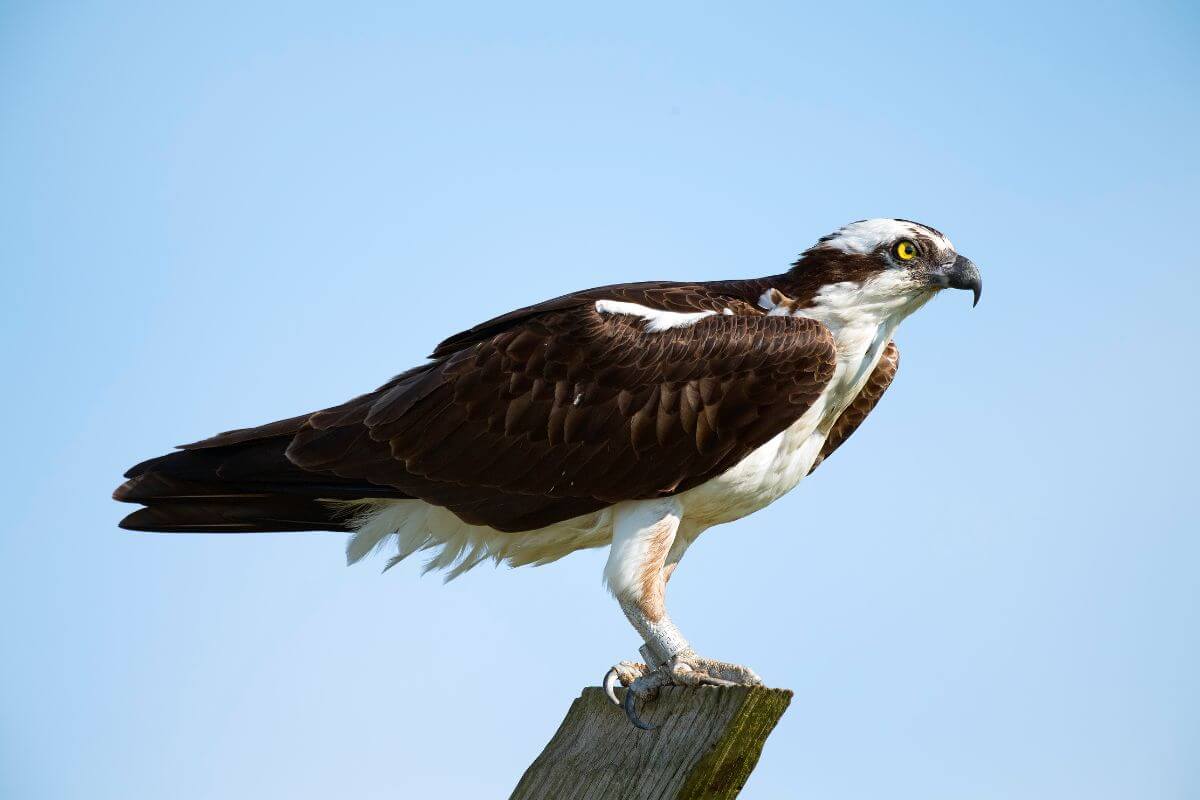
Montana is home to a remarkable Osprey, a bird of prey considered ‘fishermen of the sky.’ With their unique ability to plunge into water to catch fish, they are a vital part of the state’s ecosystem.
Explore these captivating creatures and their significance in the Treasure State.
1. Physical Characteristics of Osprey
| Characteristic | Description |
|---|---|
| Color | Ospreys are dark brown above and white below. |
| Tail | Ospreys have a barred tail. |
| Wings | Ospreys have long, narrow wings bent at the wrist when soaring. |
| Call | Ospreys have a loud, whistled call. |
| Size | Ospreys’ length ranges from 21 to 24 inches, with their wingspan ranging from 54 to 72 inches. |
The Osprey (Pandion haliaetus) stands out as a unique bird of prey, not just for its stunning appearance but for its singular place in the avian world. The Osprey is the only member of its family, Pandionidae, making it a one-of-a-kind species.
Let’s look at more interesting things to know about ospreys:
- Name Origins – The word “osprey” has its roots in the Anglo-French word “ospriet” and the Medieval Latin phrase “avis prede,” which both essentially mean “bird of prey.”
- Anatomy and Flight – Ospreys are large hawks with distinctively shaped bodies, long wings, and legs. They fly with a noticeable kink in their wings, forming an M-shape when viewed from below.
- Built for Fishing – Ospreys have reversible outer toes and barbed pads on their feet to catch and carry fish. This adaptation and their distinctive wing shape make them exceptional hunters over deep water.
- Unique Traits – Comparing Ospreys to other birds of prey, like bald eagles and hawks, reveals unique traits that define Osprey’s identity. From their white bellies to their fishing technique, Ospreys are in a class of their own.
When looking for Ospreys, listen for their whistling calls or watch for their characteristic flight pattern and powerful wingbeats. These features and their high-pitched voices make them easily identifiable in the wild.
2. Osprey Habitat
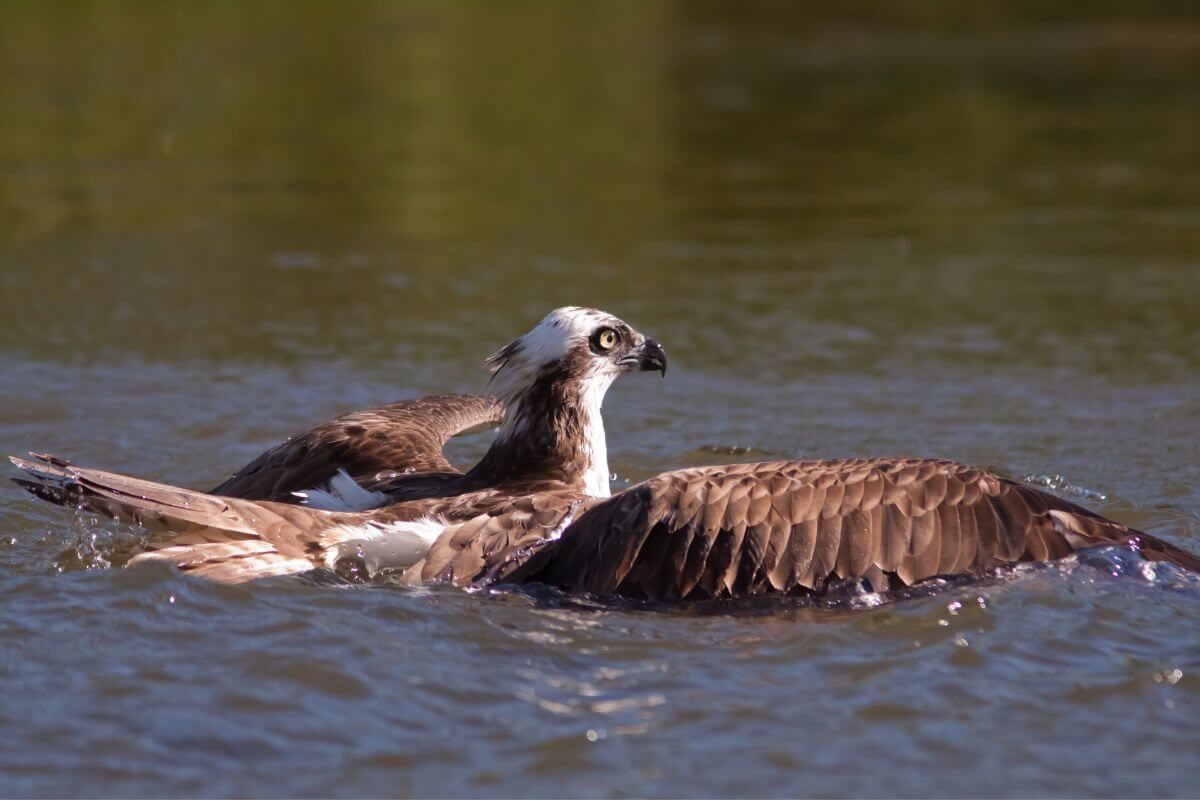
Ospreys choose their homes with a view. They prefer nesting platforms near vast water bodies in Montana, making the state’s lakes, reservoirs, and rivers prime real estate. This strategic location isn’t just about the scenery, it’s a smart move that suits their way of life.
Here’s a peek into where you can spot these magnificent birds:
- Lakes – Think of places like Yellowstone Lake. Ospreys love lakes for their calm waters and abundant fish.
- River Valleys – Osprey favorites in Montana include Hayden, Madison, Firehole, and Lamar valleys, where the rivers offer a steady fish supply.
- River Canyons – Ospreys can be found soaring high and diving for fish in places like Gardner Canyon and the Grand Canyon of the Yellowstone River.
In the upper Missouri area, Ospreys build their nests in tall trees, providing a clear view of the water. The type of tree isn’t as important as having a flat, stable surface for their nests.
Watching Ospreys in their habitat is a treat. They often glide over the water, closely examining their nesting territory. Their huge stick nests, perched atop platforms, poles, or high trees, are easy to spot. Just scan the high spots near the water, and you’ll likely see one.
These birds aren’t picky about water. You can find them near various aquatic spots, from rivers to estuaries. They’re not shy about their nests, placing them in the open on poles or dead trees right over the water.
In Montana, Ospreys shows us how important habitat relationships are. They’ve found the perfect balance between a comfortable home and easy access to food, creating a beautiful and educational sight.
3. Osprey Behavior
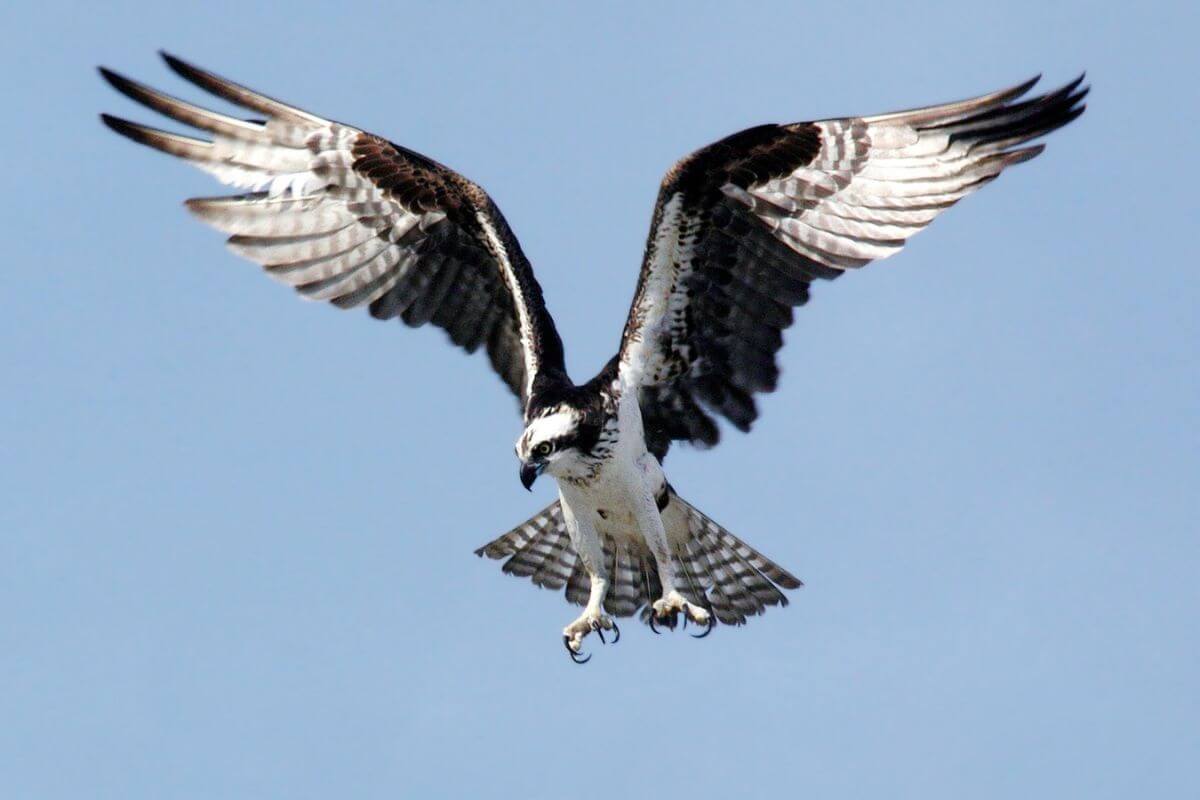
With their remarkable adaptability and unique behaviors, Ospreys offers a captivating glimpse into the avian world. Let’s look into some of their remarkable behaviors:
- Well-Adapted – Ospreys are known to thrive in the presence of humans. Osprey populations have seen a resurgence ever since DDT was banned as a pesticide.
- Solitary – Ospreys are solitary creatures that prefer their own company, often perching alone or in small winter groups of 6 to 10. They also solo travel during migration, breeding in the north and heading south for the winter.
- Aerial Exhibitionist – During the breeding season, the male osprey puts on an impressive aerial show known as the “sky-dance” or “fish-flight.” During this display, they can hover up to 600 feet, with legs dangling and sometimes carrying a fresh catch or nesting material. It can last over 10 minutes and includes loud calls and graceful descents.
Witnessing the sky-dance of an osprey or understanding its migratory journey offers a unique perspective on nature’s wonders. These birds, once on the brink of extinction, now paint the skies of Montana with their resilience and grace.
4. Osprey Food Habits
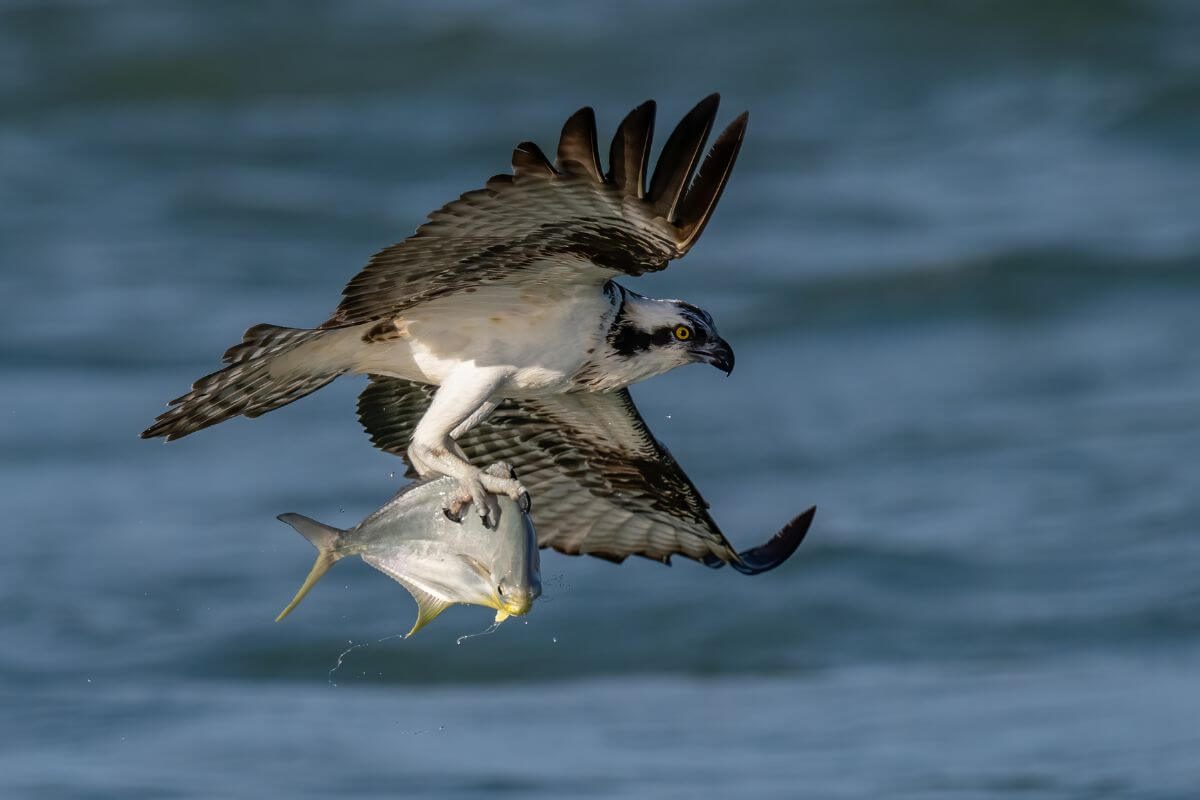
Montana’s Osprey, often called “fish hawks,” are unique in the bird world. They have a special relationship with water and the creatures within it, particularly with fish, which provide them with an abundant food supply.
These birds are the only hawks in North America with a diet that almost exclusively consists of fish. Their menu is almost entirely fresh fish, with over 80 different kinds making up their meals. They’re not picky about the fish species as long as it’s an easy catch.
So, what’s on the Osprey’s menu?
- Fish – Fish are the Osprey’s primary food, especially rough fish like suckers. They will eat a wide range of fish found in both fresh and saltwater.
- Rare Additions – Sometimes, ospreys will have a snack of perch. They rarely switch it up with fish carcasses or other animals like birds, snakes, and squirrels.
On the upper Missouri River, Ospreys favor catastomids, a type of sucker fish, as their primary catch. They also consume salmonids and cyprinids in nearly equal proportions. This adaptability is crucial for their survival, especially during the breeding season when their appetite for fish increases.
Watching an Osprey hunt is like seeing a master at work. These birds are amazing anglers. They catch fish in approximately 1 out of every 4 dives, with some instances boasting success rates as high as 70%.
When looking for fish, ospreys fly with strong, steady wingbeats and bowed wings. They either circle high above shallow water or hover briefly before diving, feet first, to snatch a fish. They carry their catch fresh-caught fish head-first to reduce wind resistance, allowing them to transport them over long distances.
5. Osprey Reproductive Characteristics
| Characteristic | Description |
|---|---|
| Clutch Size | 1-4 eggs |
| Number of Broods | 1 brood |
| Egg Length | 2.2-2.7 in (5.5-6.8 cm) |
| Egg Width | 1.6-2.0 in (4.2-5 cm) |
| Incubation Period | 36-42 days |
| Nestling Period | 50-55 days |
| Egg Description | Cream to pinkish cinnamon, spotted with brown |
| Hatching Condition | Covered with down, capable of limited motion |
Montana’s Osprey are remarkable in flight and fascinating in how they raise their young. Their choice of nesting spots and nest-building techniques reveal much about these birds.
Some essential facts about the reproductive characteristics of Ospreys in Montana include but are not limited to:
- Nesting Preferences – Ospreys choose high-up spots for their nests. Unlike eagles, they prefer dead or broken-topped trees, power poles, and other tall structures. This is where they feel most at home, raising their chicks from March to July.
- Monogamous Pairs – Most Osprey pairs in Montana stick together, season after season, sharing the duties of nesting and raising their young.
- Egg Facts – Ospreys lay between 1 and 4 eggs, which are about 2.2 to 2.7 inches long and come in a range of cream to pinkish colors with spots.
- Nest Building – The osprey nest is a joint project. The father osprey is mainly in charge of getting the building materials (lots of sticks!), and the female osprey handles the design and arrangement, adding soft materials like bark, grass, and algae.
- Hatching and Growing Up – After 36 to 42 days of waiting, the eggs hatch. But it’s not an instant family, the first chick can be born up to 5 days before the last one. The chicks then spend 50 to 55 days in the nest before taking their first flights.
Ospreys in Montana are not just passing through, they’re setting up their homes high above us. They are showing off their parenting skills in full view.
The Montana Osprey Project
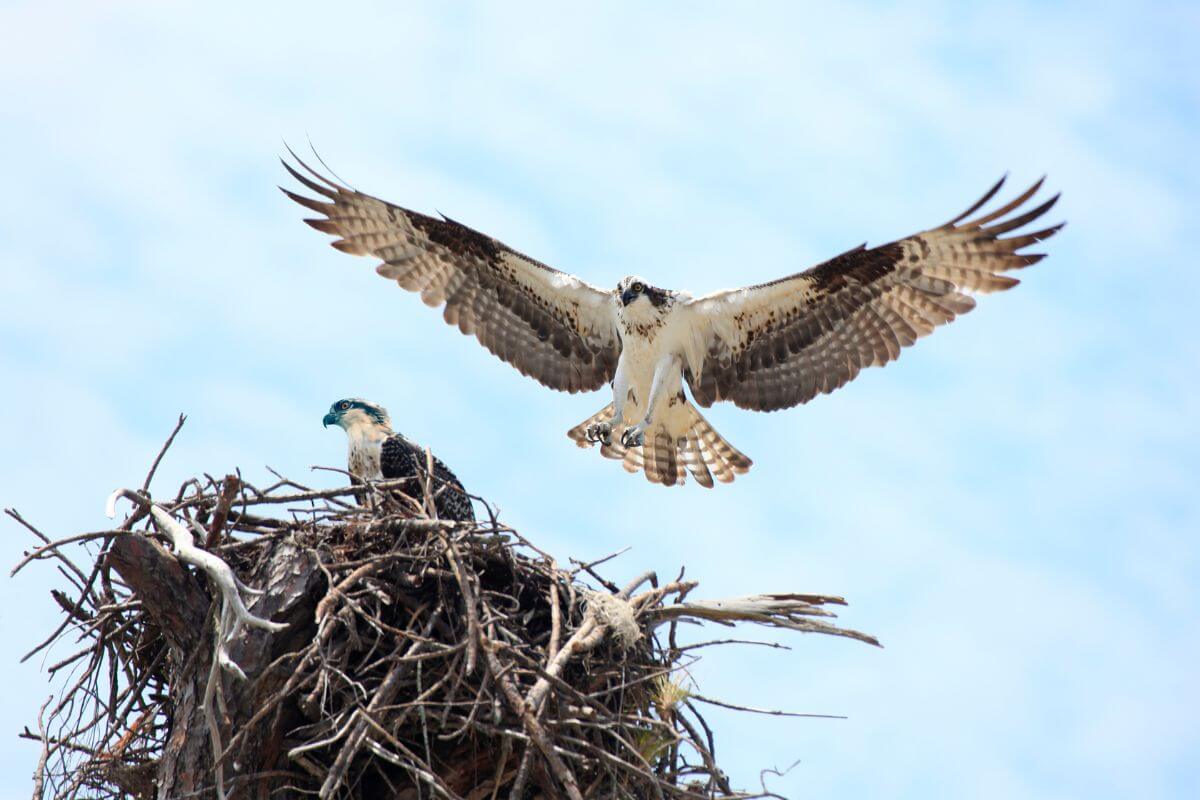
The Montana Osprey Project is a big deal. It investigates the lives of Ospreys and heavy metal contamination of the upper Clark Fork River in Montana and its tributaries.
The project is lucky to get money from the University of Montana, the Cornell Lab of Ornithology, and many small donations. Also, a Montana Natural Resources Damage Program grant helps teach and reach out to people.
As part of this project, two nest cams show live footage. One is in Missoula at Hellgate Canyon, and the other is in Lolo at Dunrovin Ranch. Ospreys shown in these live cams are part of a big project that checks how healthy the water and Ospreys are in western Montana.
Ospreys are at the top of the food chain, teaching us much about the environment. The young Ospreys only eat fish from close to home, so they tell us about the local fish population and water quality.
After World War II, Ospreys were in big trouble in the Lower 48 states because of a pesticide called DDT. The number of ospreys dropped dramatically, making people wonder what was wrong with the environment. A ban on DDT in 1972 helped bring back the Ospreys. Studies like this one now monitor Ospreys and the water to ensure their health.
Montana Osprey Live Cams
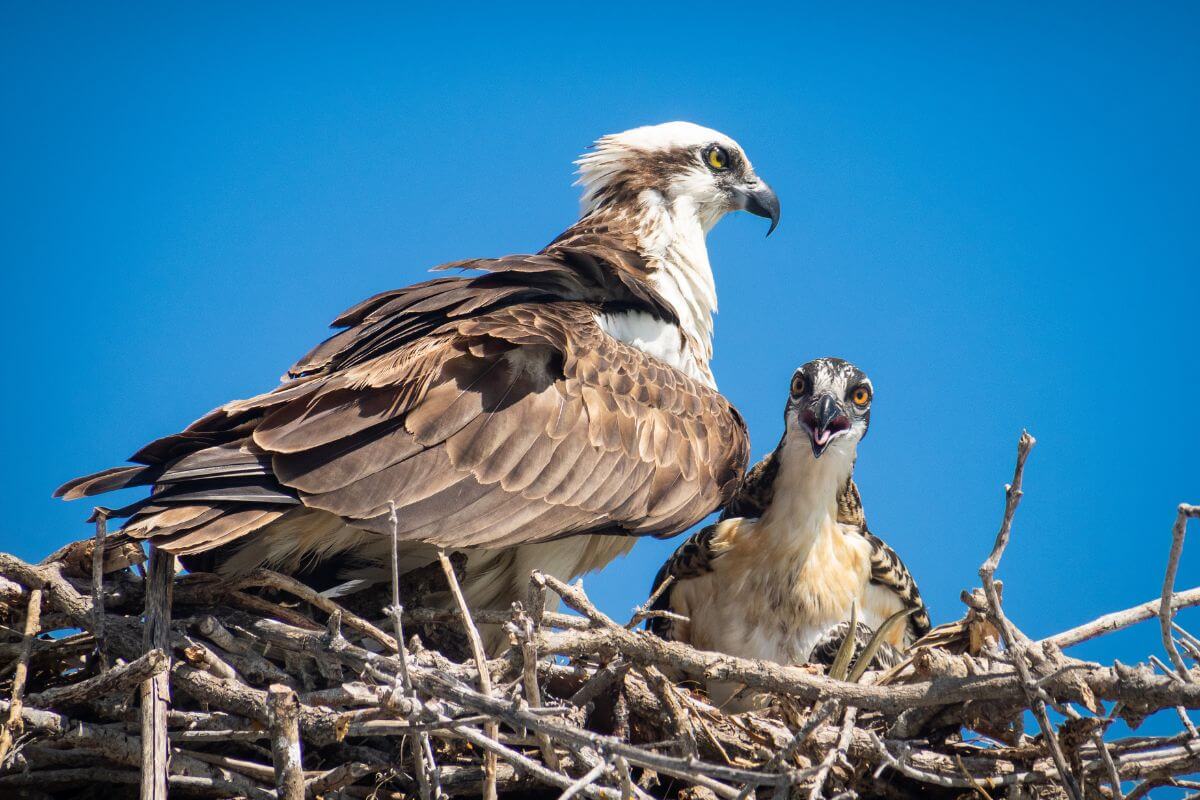
Watching Montana’s ospreys live is a thrilling and educational experience. You can get a front-row seat to these fascinating birds’ lives thanks to live cameras. These live streams serve as valuable educational tools, bringing the wonders of nature and science closer to home.
Here’s a look at the osprey live cams in Montana:
| Osprey Habitats | Description | Live Cam |
|---|---|---|
| Hellgate Canyon Ospreys | Located at the mouth of Hellgate Canyon, near Missoula, the nest is home to Louis and Iris. Iris, known for her uniquely spotted iris, has nested here for years and is one of the world’s oldest breeding ospreys. Louis, named after a local elder, has been her mate since 2016. | Watch here |
| Dunrovin Ranch Ospreys | In Montana’s Bitterroot Valley at Dunrovin Ranch, meet Ozzie, Harriett, and their chicks. The Millers, who own the ranch, collaborate with the University of Montana to study these ospreys. Their calls mark the seasons and are a cherished part of ranch events, including weddings. | Watch here |
| Charlo Ospreys | Nestled near a great horned owl family in Charlo, Montana, Charlie and Charlotte have a cozy nest with a view. They are raising their family here. | Watch here |
These live cams offer news for osprey lovers and a unique insight into the lives of these magnificent birds. Whether it’s the Hellgate Canyon ospreys’ urban resilience, the Dunrovin pair’s scientific contribution, or Charlo’s peaceful family life, there’s something for everyone to enjoy and learn from.
Montana Osprey Final Thoughts
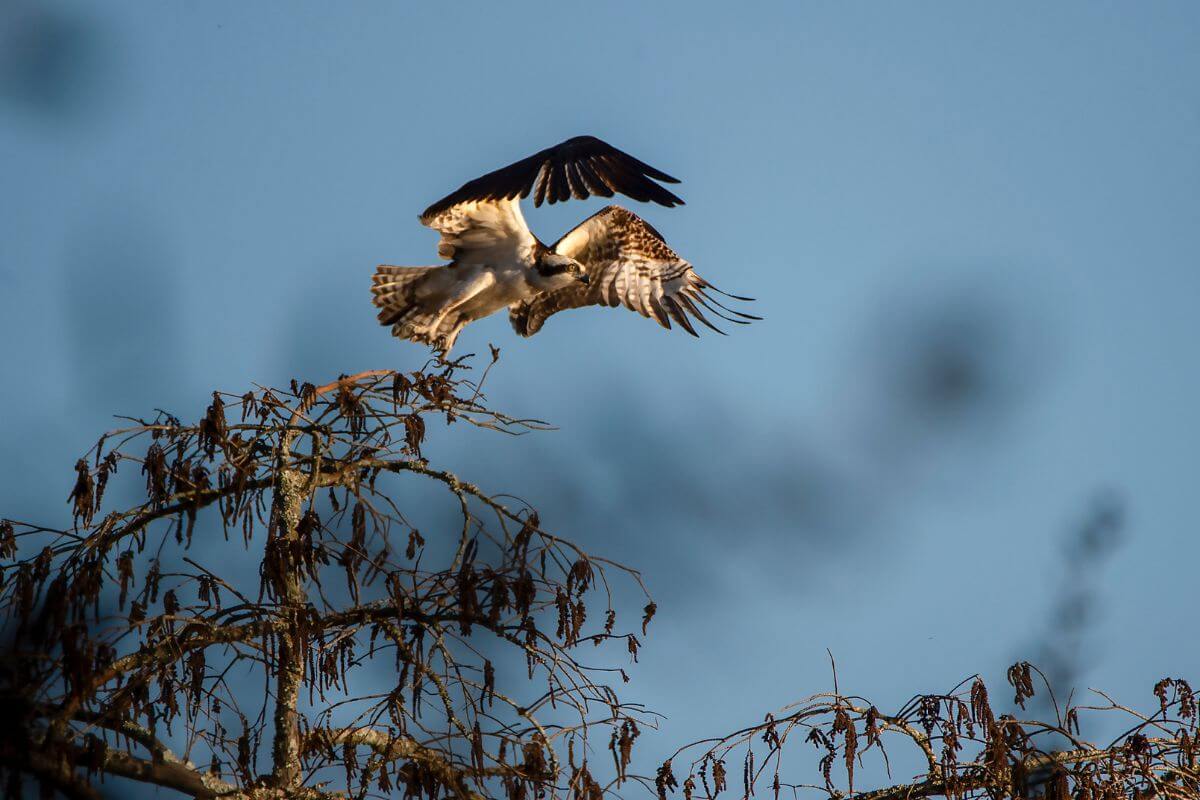
The Montana Osprey symbolizes nature’s grandeur in the Treasure State with its unrivaled fishing abilities and distinct presence. Easily recognizable by their unique coloration, size, and whistle sound, these birds play a vital role in Montana’s ecosystem.
Nesting near the state’s expansive water bodies, from peaceful lakes to flowing rivers, they perfectly balance habitat selection and food access. Through their almost exclusive fish diet, Ospreys shows us how specialization and adaptability are key to survival.
Supported by live cams providing a close-up view of these magnificent birds, the Montana Osprey Project emphasizes their importance as environmental indicators. The cams offer an intimate look at their behavior and habitat, aiding in scientific research and public awareness efforts.
This ongoing effort safeguards the Ospreys of Montana. It contributes to the broader environmental well-being. This leaves us with a profound appreciation for these majestic creatures and the natural world they inhabit.
Montana Osprey FAQs
1. Are There Ospreys in Montana?
There are ospreys in Montana. Ospreys are migratory birds of prey commonly found near bodies of water such as rivers, lakes, and reservoirs.
2. Do Osprey Migrate in Montana?
Ospreys do migrate through Montana. They travel between their breeding grounds in North America during the summer months and their wintering grounds in Central and South America during the winter. In Montana, ospreys can be observed during their migration periods in the spring and fall as they travel to and from their breeding and wintering areas.
3. Are There Osprey in Yellowstone?
Ospreys can be found in Yellowstone National Park. While they are not as abundant as in some other parts of the state, ospreys are known to inhabit areas near rivers, lakes, and other bodies of water within the park.
4. Is an Osprey Rare?
Ospreys are not considered rare broadly, as they are widespread across much of North America, Europe, Africa, and Asia. However, their abundance can vary depending on habitat availability, prey abundance, and conservation efforts.
5. Are Osprey Like Eagles?
Ospreys and eagles share similarities as large birds of prey that hunt for fish, but they have differences in their hunting techniques and physical appearance. Ospreys are known for their unique ability to dive feet-first into the water to catch fish, while eagles typically hunt from above and swoop down to capture prey.
Additionally, ospreys have distinctive white underparts and heads, while eagles often have more uniform coloration.
Discover these articles celebrating Montana:

